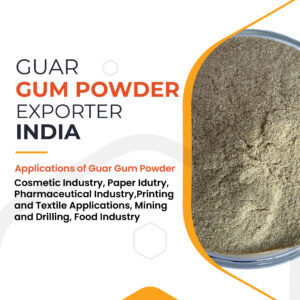In the realm of food-related applications, there has been an ongoing discourse surrounding the utilization of guar gum. A decade ago, concerns arose regarding the extensive use of pesticides in the production of guar gum. However, strides have been made to address and resolve this issue.
Within the European Union, an expert panel evaluation of this food additive determined that there were no discernible adverse effects on the human body with sustained consumption of guar powder in food products.
Guar gum powder serves a multitude of functions in the production of processed foods. It acts as both a stabilizer and thickener, finding its way into a plethora of consumables including dairy products, soups, and dietary supplements.
Action in the Digestive System
In the realm of digestive system dynamics, this substance boasts a remarkable talent: liquid absorption. In comparison to counterparts such as corn starch and locust bean powder, it reigns supreme as a superior thickening agent.
Studies delving into the aqueous prowess of guar gum reveal a staggering revelation: its capacity to retain water surpasses that of other hydrocolloids by more than eightfold.

Natural Alternative
Guar powder’s effectiveness rivals, or even surpasses, that of hydrocolloids like carrageenan, long utilized in culinary pursuits. In the realm of nutrition, food-grade guar gum plays a vital role in regulating blood sugar and reducing cholesterol levels. However, caution is advised due to the extensive attention drawn to its alleged weight loss benefits, attributed to its water-absorbing properties.
When it comes to baked goods, it serves a vital role in crafting recipes tailored for those with gluten sensitivities. Functioning as a substitute for wheat flour, it seamlessly imparts the dough with identical baking properties, ensuring a delightful gluten-free experience.
Binding Ingredients Together
When crafting dairy products, guar powder serves as a highly efficient agent, enhancing texture and viscosity. Its role extends to maintaining the cohesion of thinner elements like water or coconut oil within the blend.
Creating a Satiated Feeling
Incorporating this product into food can lead to diminished digestibility, along with a tendency to expand within the digestive tract, inducing a sensation of fullness. Moreover, it serves a dual purpose as a laxative, aiding in the regulation of digestion by slowing down the process and mitigating the absorption of cholesterol. Its mechanism involves decreasing the viscosity of ingested foods within the gut, thus rendering it instrumental in managing weight-related concerns.
Guar Gum Drawbacks
Ingested in significant amounts, it swiftly conglomerates into a dense mass, often associated with severe health implications such as pulmonary embolism, esophageal rupture, and obstructive luminal complications.
In Supplements
When incorporating it into supplements, excessive intake should be steered clear of to mitigate potential problems such as constipation or blockages in the intestines. For those adhering to weight loss programs, opting for glucomannan powder has emerged as a safer alternative, aiming to circumvent these complexities altogether.
Emulsifiers in Foods
In the realm of food research, emulsifiers have garnered considerable attention. Conventional wisdom suggests that these additives might impact the delicate balance of intestinal flora, potentially perturbing the protective mucus layer in the gut. However, ongoing investigations have yet to conclusively validate these hypotheses..
Conclusion
Guar powder’s impact on food has undergone extensive examination. Its primary notable effects as a food supplement include weight loss and decreased glucose levels.


This Post Has 0 Comments